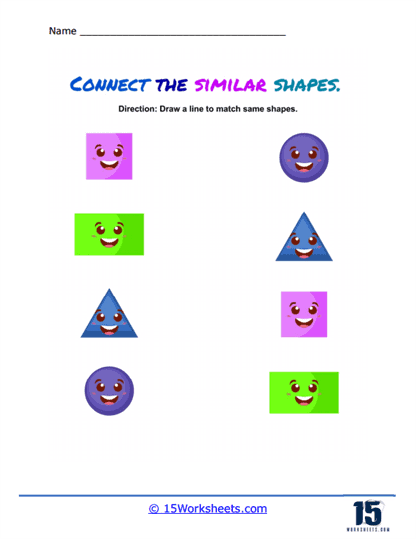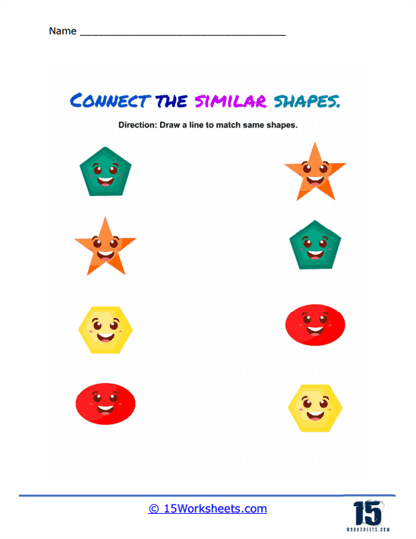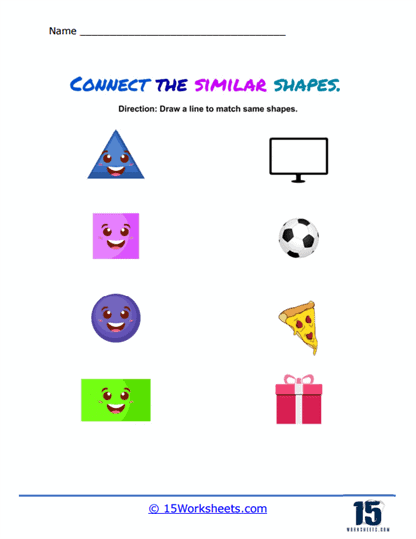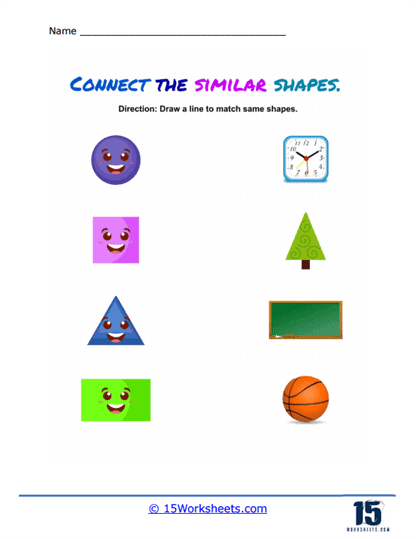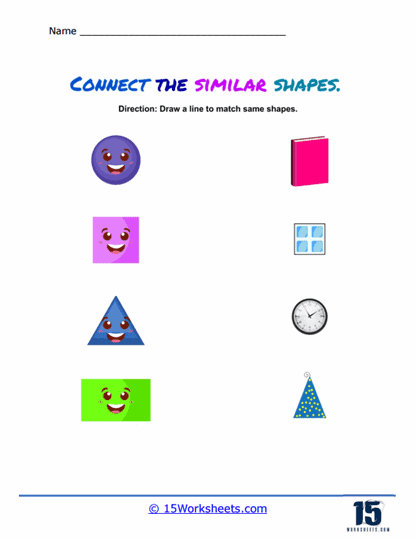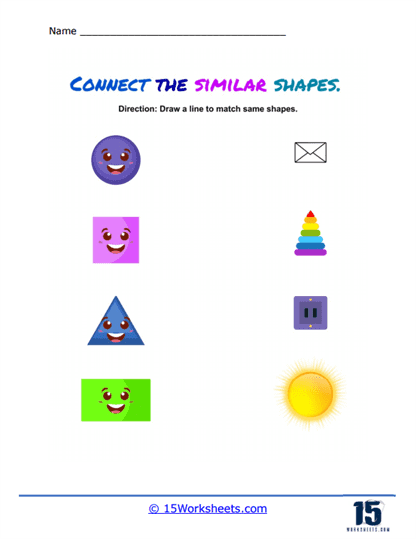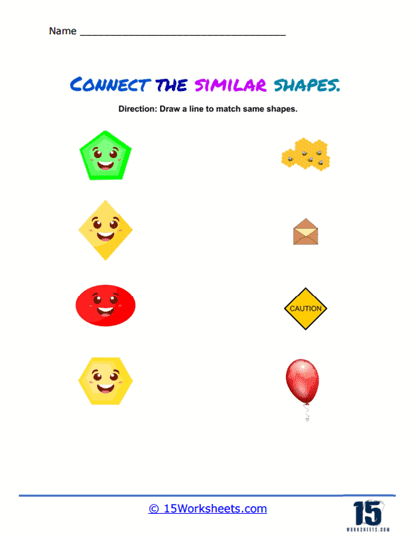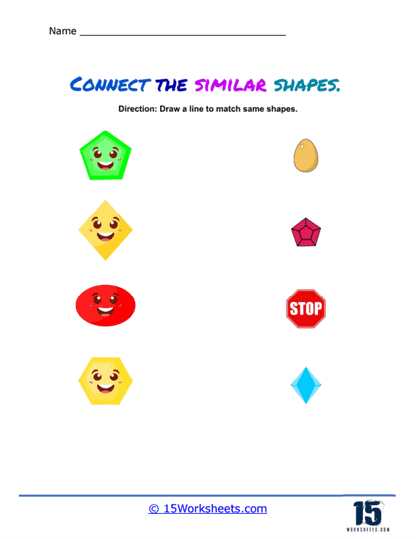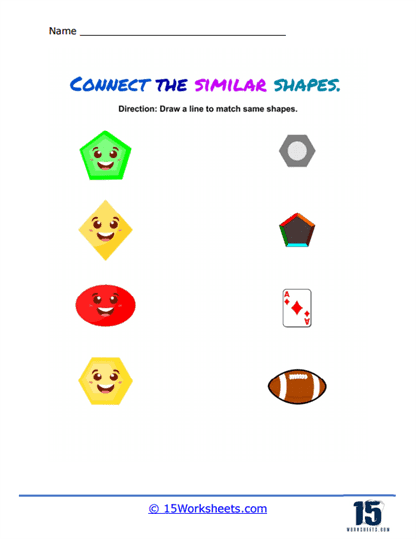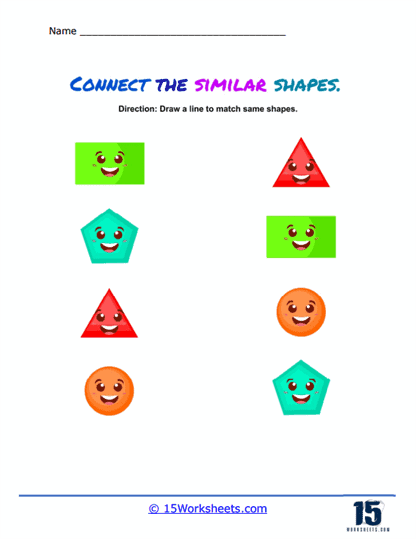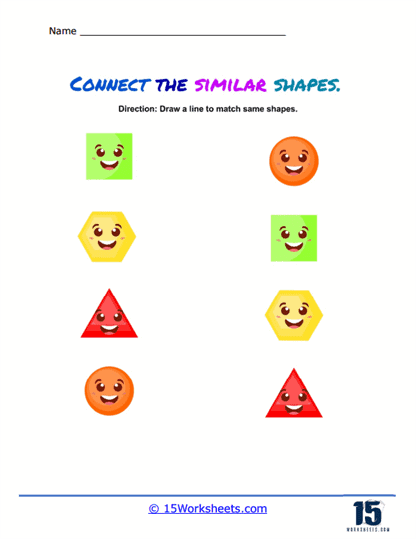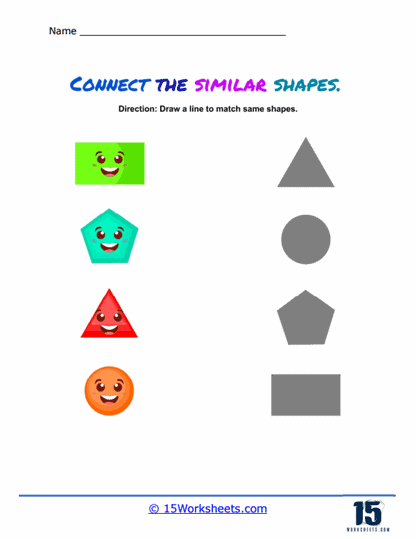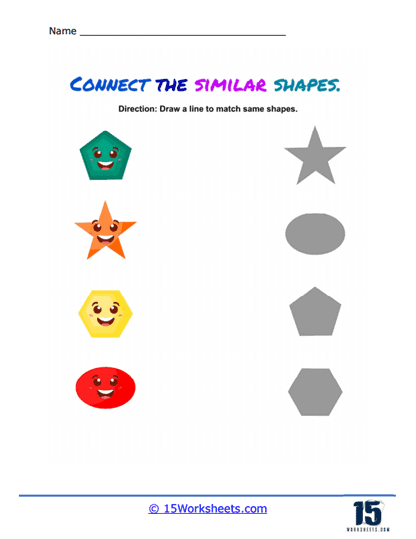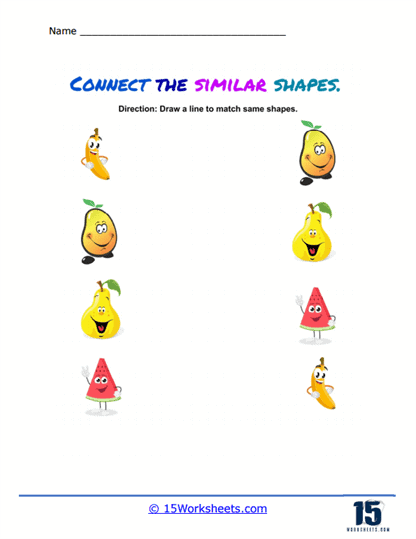Matching Similar Shapes Worksheets
About These 15 Worksheets
Matching similar shapes involves identifying and comparing shapes that have the same form but might differ in size, orientation, or location.
Matching similar shapes worksheets are beneficial for children in several ways. They promote visual perception skills, as children must carefully observe the shapes and compare their attributes to determine their similarities. By engaging in this activity, children learn to identify and differentiate shapes based on their characteristics, such as the number of sides or the presence of curved lines.
To match similar shapes, you can follow these steps:
Determine the shape category – First, identify the basic shape category (e.g., circle, square, triangle, rectangle, etc.) of the shapes you are comparing. If they belong to different categories, they cannot be similar.
Count the number of sides – If the shapes are polygons, count the number of sides. If they have a different number of sides, they are not similar.
Check for corresponding angles – Compare the angles of the shapes. If the shapes are similar, their corresponding angles should be equal. For example, if two triangles have angles of 60, 60, and 60 degrees and 40, 50, and 90 degrees, respectively, they are not similar.
Examine side ratios – Measure the lengths of the corresponding sides of the shapes. If the shapes are similar, the ratios of their corresponding sides should be proportional. For example, if the ratio of the sides of two similar triangles is 1:2, all corresponding sides should maintain that ratio (e.g., 3 cm and 6 cm, 4 cm and 8 cm, etc.).
Consider orientation and location – Similar shapes may have different orientations or locations. Rotate, reflect, or translate one shape to see if it can be aligned with the other. If they can be aligned, and the angles and side ratios are the same, they are similar.
Note that some shapes, like circles and ellipses, do not have sides or angles to compare. In these cases, you can check for similarity by comparing properties like radii or axes lengths.
These worksheets also foster critical thinking and problem-solving skills. Children must analyze the attributes of each shape and make logical connections to match them correctly. Additionally, matching similar shapes helps children develop their vocabulary and language skills by associating shape names with their visual representations.
What Are Similar Shapes?
Understanding similar shapes and the ability to perceive basic geometric forms in everyday structures and objects are fundamental skills in geometry. Similar shapes are geometric figures that share the same shape but may vary in size. They maintain identical proportions and angles, making them congruent to each other. To help people see basic geometric shapes in the world around them, it’s crucial to develop a keen sense of observation and recognize patterns.
One of the primary strategies to enhance this skill is to visualize fundamental shapes. Familiarizing oneself with the basic geometric shapes such as circles, squares, triangles, rectangles, and hexagons is the first step. Practice mentally visualizing these shapes in their ideal, pure forms. This mental exercise prepares the mind to identify these shapes in various contexts.
Breaking down complex structures into simpler geometric components is another effective approach. When confronted with intricate objects or structures, mentally deconstruct them into basic shapes. For instance, a door can be seen as a large rectangle, and a window might resemble a smaller square or rectangle. This simplification helps in recognizing shapes in real-world scenarios.
Identifying proportions is crucial when trying to see basic geometric shapes. Similar shapes often maintain consistent ratios between their sides or angles. For example, a stop sign is an octagon with equal side lengths and angles, making it similar to other octagonal shapes. Paying attention to these proportional relationships aids in recognizing shapes that may not be perfectly regular but still share fundamental attributes.
Symmetry is a key characteristic of many geometric shapes. When trying to identify shapes in everyday objects, look for symmetry. Determine if an object exhibits lines of symmetry or rotational symmetry. Recognizing symmetry can often lead to the identification of basic shapes within more complex structures.
Extending the perception to three-dimensional objects is also important. While basic geometric shapes typically refer to two-dimensional forms, recognizing three-dimensional shapes in everyday objects is equally valuable. For instance, a can of soda is a cylinder, and a soccer ball is a sphere. Identifying these shapes in 3D enhances the ability to see geometry in the physical world.
Comparative thinking is a powerful tool for recognizing shapes. When encountering an object, compare it to known geometric shapes in your mental catalog. Ask yourself which geometric shape it most closely resembles and whether it is a scaled or rotated version of that shape. This comparative approach sharpens the ability to spot geometric forms in various objects.
Visual aids, such as diagrams, illustrations, or apps that overlay geometric shapes onto real-world images, can provide tangible references for recognizing shapes. These aids serve as valuable educational tools and can assist in identifying shapes more accurately.
Engaging with educational resources, whether through books, online courses, or tutorials, can significantly improve shape recognition skills. These resources often offer exercises and examples that guide individuals in developing their geometric perception.
Moreover, incorporating real-life examples and discussions into everyday activities can be beneficial, particularly when teaching children or students about shapes. Pointing out shapes during walks, in the home, or within architectural structures can enhance their awareness and encourage them to see geometry in the world around them.
Ultimately, like any skill, the ability to see basic geometric shapes in everyday objects improves with practice. Regularly challenging oneself to identify shapes in new contexts and environments is essential for honing this skill. By mastering the art of recognizing shapes in everyday life, individuals can gain a deeper appreciation for the role of geometry in shaping our physical surroundings and better understand the fundamental principles underlying our environment.

